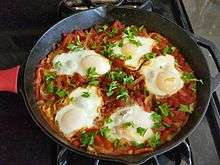Shakshouka
Shakshouka (Arabic: شكشوكة, also spelled shakshuka or chakchouka) is a dish of eggs poached in a sauce of tomatoes, olive oil, peppers, onion and garlic, and commonly spiced with cumin, paprika, cayenne pepper and nutmeg. The dish has existed in Mediterranean cultures for centuries.[1][2][3]
 Shakshouka in a cast iron pan | |
| Alternative names | Shakshuka, chakchouka |
|---|---|
| Place of origin | Disputed; Maghreb, Ottoman Empire or Yemen |
Etymology
The word shakshouka (Arabic: شَكْشُوكَةٌ) is Maghrebi Arabic[4] for "a mixture".[2][5][6][7]
History
Tomato-based stews, called shakshouka in the Maghreb, were common throughout the Middle East and former Ottoman Empire. The Ottoman dish şakşuka was originally a dish of cooked vegetables with minced meat or liver (ciġer). Tomato and chili peppers hot/sweet were introduced to the dish much later both having their origin in the Americas and meatless variations evolved. Jews in the Ottoman Maghreb served a pareve vegetarian variation and Tunisian Jews were known for creating spicy versions of egg shakshouka.[8]
The exact origins of the dish are disputed. Some food historians believe the dish spread to Spain and the greater Middle East from Ottoman Turkey, while others think it originated in Morocco. A third theory is that it is from Yemen, where it is served with zhug, a hot green paste.[9] According to Haaretz the "original shakshuka" was made with vegetables, hard-boiled eggs, goat meat and fresh garlic.[10]
The dish was brought to Israel by Tunisian Jews as part of the mass Jewish exodus from Arab and Muslim lands, where it has become a characteristic feature of the local cuisine.[11][8]
Shakshouka is typical of North African and Arab cuisine and is traditionally served in a cast iron pan or, in Morocco, a tajine.
Variations

Some variations of shakshouka can be made with lamb mince, toasted whole spices, yogurt and fresh herbs.[12] Others may include salty cheeses such as feta.[13][14] Spices can include ground coriander, caraway, paprika, cumin and cayenne pepper.[15][14] Tunisian cooks may add potatoes, broad beans, artichoke hearts or courgettes to the dish.[16] The North African dish matbukha can be used as a base for shakshouka.[17]
In Israel, shakshouka is made with eggs which are commonly poached but can also be scrambled like the Turkish menemen.[11][8] A 1979 Israeli cookbook Bishul la-Gever ha-Meshuhrar includes a recipe for lufgania shakshuka. This is shakshouka made with a kosher version of Spam (called loof) that was added to IDF army rations in the 1950s.[18] Because eggs are the main ingredient, it is often on breakfast menus, but in Israel, it is also a popular evening meal,[13] and like hummus and falafel, is a national favorite.[9]
See also
| Wikiquote has quotations related to: Shakshouka |
References
- Roden, Claudia (2008). The New Book of Middle Eastern Food. Knopf Doubleday Publishing Group. p. 168. ISBN 9780307558565.
- Ly, Linda (2015-03-20). The CSA Cookbook: No-Waste Recipes for Cooking Your Way Through a Community Supported Agriculture Box, Farmers' Market, Or Backyard Bounty. Voyageur Press. ISBN 9780760347294. Archived from the original on 2017-11-16. Retrieved 2017-11-15.
- Stafford, Alexandra (2017-04-04). Bread Toast Crumbs: Recipes for No-Knead Loaves & Meals to Savor Every Slice. Potter/TenSpeed/Harmony. ISBN 9780553459845. Archived from the original on 2017-11-16. Retrieved 2017-11-15.
- Ellis, Robin (2016-03-03). Mediterranean Cooking for Diabetics: Delicious Dishes to Control or Avoid Diabetes. Little, Brown Book Group. ISBN 9781472136381. Archived from the original on 2017-11-16. Retrieved 2017-11-15.
- Planet, Lonely (2017-03-01). The World's Best Superfoods. Lonely Planet. ISBN 9781787010369. Archived from the original on 2017-11-16. Retrieved 2017-11-15.
- Bilderback, Leslie (2015-09-01). Mug Meals: More Than 100 No-Fuss Ways to Make a Delicious Microwave Meal in Minutes. St. Martin's Press. ISBN 9781466875210. Archived from the original on 2017-11-16. Retrieved 2017-11-15.
- Jakob, Ben. "How Shakshuka,, Took the World By Storm". Culture Trip. Archived from the original on 2017-11-16. Retrieved 2017-11-15.
- Encyclopedia of Jewish Food, Houghton Mifflin Harcourt, 17 Nov 2010, By Gil Marks
- Josephs, Bernard (2009-10-08). "Shakshuka: Israel's hottest breakfast dish". The Jewish Chronicle. Archived from the original on 2017-08-08. Retrieved 2017-08-07.
- Tiroche, Limor Laniado (2012). "Tips for Making a Better Shakshuka".
- Artzeinu: An Israel Encounter, By Joel Lurie Grishaver, 2008
- Gordon, Peter (2018-06-03). "Peter Gordon's lamb shakshouka recipe". The Guardian. ISSN 0261-3077. Retrieved 2018-07-21.
- Clifford-smith, Stephanie (2011-06-07). "Three of a kind ... shakshouka". Sydney Morning Herald. Archived from the original on 2017-08-08. Retrieved 2017-08-07.
- Clark, Melissa. "Shakshuka With Feta Recipe". NYT Cooking. Retrieved 2018-07-21.
- "Shakshouka Recipe - Tunisian Recipes". PBS Food. 2015-03-12. Retrieved 2018-07-21.
- Claudia Roden (1996). The Book of Jewish Food: An Odyssey from Samarkand to New York. Knopf. p. 512. ISBN 9780394532585.
- Gur, Janna (2014). Jewish Soul Food: From Minsk to Marrakesh.
- Raviv, Yael (November 2015). Falafel Nation: Cuisine and the Making of National Identity in Israel. University of Nebraska Press. p. 171. ISBN 978-0-8032-9023-5.